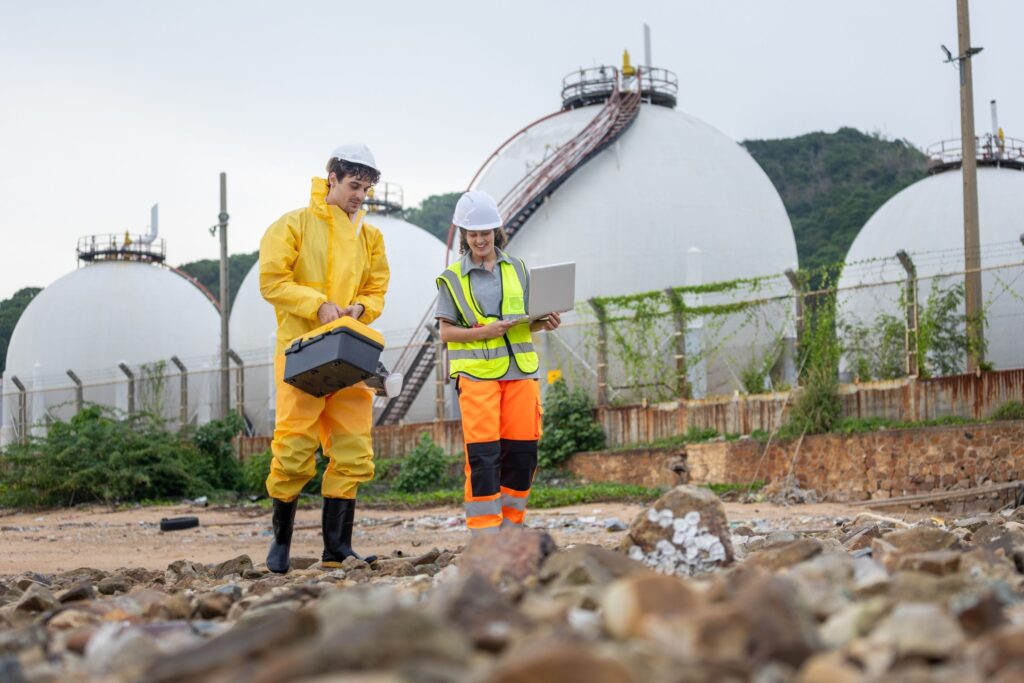Work zones are more than just areas marked by cones and caution tape; they are complex, high-risk environments where precision, awareness, and safety come together to protect both workers and the public. In civil, heavy, and underground construction, the stakes are even higher. Every day, crews operate near heavy equipment, unstable ground, and moving vehicles. One small oversight can lead to costly delays or serious accidents.
At Discovery Experts, our team has seen firsthand how diligent planning and analysis can make the difference between a project that runs smoothly and one that faces safety-related shutdowns or litigation. Understanding work zone safety isn’t just a regulatory checkbox; it’s a foundation for quality, accountability, and public trust.
Why Work Zone Safety Matters in Heavy and Underground Construction
The High-Risk Nature of Work Zones
Every work zone carries its own unique challenges. In heavy and underground construction, workers often find themselves in confined spaces, operating large equipment next to active traffic, or navigating unstable terrain. Imagine trying to coordinate multiple crews in a trench while monitoring overhead hazards and maintaining communication with surface teams, it takes constant vigilance.
Even with experience and training, risk remains a constant factor. The combination of physical exertion, noise, and environmental pressure creates conditions where small mistakes can have serious consequences. This is why a culture of safety awareness must be embedded at every level of a construction organization.
OSHA and DOT Regulations That Govern Work Zones
Safety rules aren’t arbitrary. Agencies like OSHA and the Department of Transportation have established clear standards to protect workers and the public. These include requirements for personal protective equipment, traffic control signage, and site visibility. Regular compliance checks can mean the difference between a successful project and a legal or financial setback.
In practice, strong compliance does more than prevent citations, it builds credibility. When project teams follow the right procedures, they demonstrate responsibility and professionalism to clients, regulators, and communities alike.
Common Causes of Work Zone Accidents and Delays
Human Factors and Training Gaps
Many incidents occur not because of faulty machinery, but because of human factors; fatigue, miscommunication, or incomplete training. A tired operator or an untrained flagger can inadvertently create dangerous situations. Investing in ongoing safety training is an investment in your workforce’s long-term performance and wellbeing.
For example, a simple pre-shift safety meeting that reinforces clear hand signals or proper equipment startup procedures can prevent an accident before it happens. These proactive habits strengthen team accountability and awareness.

Equipment and Site Management Errors
Equipment breakdowns, poor lighting, and unclear traffic control plans remain some of the biggest contributors to work zone accidents. Regular maintenance, proper signage, and site audits ensure that risks are spotted early. Partnering with a qualified safety expert can help identify issues before they escalate into serious problems or project delays.
Legal Implications for Contractors and Engineers
When safety fails, liability questions often follow. Contractors and engineers may face investigations into whether due diligence was followed. Thorough documentation, training records, inspection reports, and safety meeting logs, can make or break a case. These are exactly the types of records that expert witnesses analyze during construction litigation.
How Labor Analysis Enhances Work Zone Safety
The Role of Data in Safety Performance Tracking
Construction labor analysis provides more than productivity metrics; it offers a window into workforce health and safety. By examining crew scheduling, task efficiency, and incident frequency, analysts can uncover hidden stress points that increase accident risk. Data doesn’t just tell you what happened; it reveals patterns that predict what could happen next.
For instance, if labor data shows that crews working extended overtime shifts experience higher minor injury rates, management can intervene by rotating shifts or increasing rest breaks. These insights turn raw numbers into actionable safety improvements.
Integrating Labor Analysis into Risk Management Plans
Combining safety data with workforce analytics helps companies create smarter risk management plans. A project that understands its labor dynamics can prevent both inefficiencies and safety breakdowns. This integrated approach aligns perfectly with the analytical methods described on our construction delay and cause analysis page, where operational data and field observations work hand in hand to reveal root causes and solutions.
Ultimately, effective labor analysis does more than improve safety metrics, it fosters accountability, transparency, and informed decision-making across the entire construction process.
Expert Witness Insights on Work Zone Safety and Accident Analysis
How Experts Evaluate Work Zone Conditions
When an accident occurs, determining what went wrong often requires an independent expert’s perspective. Expert witnesses review project records, site photos, safety manuals, and field data to assess whether proper procedures were followed. They look beyond the surface, evaluating everything from traffic control patterns to worker positioning during critical tasks.
This level of scrutiny helps clarify whether an incident was a result of negligence, equipment failure, or unavoidable circumstance. The conclusions drawn from such evaluations often play a decisive role in resolving disputes fairly.
The Value of Expert Testimony in Work Zone Litigation
Expert testimony gives clarity to complex technical matters in court. A well-prepared expert can explain construction standards and industry practices in a way that judges and juries understand. Through mediation, deposition, and trial support services, Discovery Experts provides the credible analysis that legal teams depend on to build strong, fact-based cases.
These insights not only assist in legal proceedings but also help construction firms identify systemic issues and implement long-term preventive strategies.

Best Practices for Maintaining Safe and Compliant Work Zones
Safety doesn’t happen by accident, it’s the result of daily discipline, communication, and teamwork. A well-structured safety program includes more than compliance; it creates a culture where everyone takes responsibility for protecting themselves and others. Below are practical steps that can improve on-site safety and compliance:
Work Zone Safety Checklist
- Hold daily safety meetings to review potential hazards and responsibilities.
- Ensure every team member uses proper PPE and knows its purpose.
- Inspect and maintain all tools, vehicles, and equipment regularly.
- Implement clear traffic control systems for both vehicles and pedestrians.
- Keep detailed documentation, training logs, incident reports, and inspection notes.
Adding external oversight can also strengthen compliance. Regular third-party audits from a construction safety expert provide an unbiased evaluation of how effectively safety policies are implemented. These reviews not only enhance safety but also create defensible evidence in the event of litigation or regulatory review.
Conclusion: Strengthening Work Zone Safety Through Analysis and Expertise
Work zone safety is far more than a set of checklists; it’s a mindset that shapes every decision on the jobsite. Combining human awareness with analytical tools, labor insight, and expert consultation creates a holistic approach that keeps teams safe and projects on schedule.
If your organization is facing safety challenges, delay claims, or litigation, our specialists can help. Visit our Civil, Heavy, Underground Construction Delay Cause and Analysis page for deeper insights, or contact Discovery Experts today to speak directly with a construction and safety expert.

